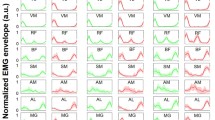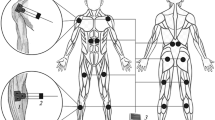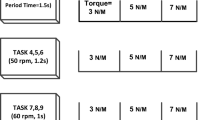Abstract
Running is an exercise that can be performed in different environments that imposes distinct foot–floor interactions. For instance, running on grass may help reducing instantaneous vertical impact loading, while compromising natural speed. Inter-muscular coordination during running is an important factor to understand motor performance, but little is known regarding the impact of running surface hardness on inter-muscular coordination. Therefore, we investigated whether inter-muscular coordination during running is influenced by running surface. Surface electromyography (EMG) from 12 lower limb muscles were recorded from young male individuals (n = 9) while running on grass, concrete, and on a treadmill. Motor modules consisting of weighting coefficients and activation signals were extracted from the multi-muscle EMG datasets representing 50 consecutive running cycles using non-negative matrix factorization. We found that four motor modules were sufficient to represent the EMG from all running surfaces. The inter-subject similarity across muscle weightings was the lowest for running on grass (r = 0.76 ± 0.11) compared to concrete (r = 0.81 ± 0.07) and treadmill (r = 0.78 ± 0.05), but no differences in weighting coefficients were found when analyzing the number of significantly active muscles and residual muscle weightings (p > 0.05). Statistical parametric mapping showed no temporal differences between activation signals across running surfaces (p > 0.05). However, the activation duration (% time above 15% peak activation) was significantly shorter for treadmill running compared to grass and concrete (p < 0.05). These results suggest predominantly similar neuromuscular strategies to control multiple muscles across different running surfaces. However, individual adjustments in inter-muscular coordination are required when coping with softer surfaces or the treadmill’s moving belt.





Similar content being viewed by others
References
Abbasi A, Yazdanbakhsh F, Tazji MK, Ataabadi PA, Svoboda Z, Nazarpour K, Vieira MF (2020) A comparison of coordination and its variability in lower extremity segments during treadmill and overground running at different speeds. Gait Posture 79:139–144
Abdul Yamin NAA, Basaruddin KS, Salleh AF, Salim MS, Wan Muhamad WZA (2021) Effects of running surface stiffness on three-segment foot kinematics responses with different shod conditions. Appl Bionics Biomech. https://doi.org/10.1155/2021/8842591
Albertus-Kajee Y, Tucker R, Derman W, Lamberts RP, Lambert MI (2011) Alternative methods of normalising EMG during running. J Electromyogr Kinesiol 21(4):579–586. https://doi.org/10.1016/j.jelekin.2011.03.009
ASTM-F-2117–10 (2017) Standard test method for vertical rebound characteristics of sports surface/ball systems. Acoustical Measurement; ASTM International, West Conshohocken
Barbero M, Merletti R, Rainoldi A (2012) Atlas of muscle innervation zones: understanding surface electromyography and its applications. Springer Science & Business Media
Barnamehei H, Tabatabai Ghomsheh F, Safar Cherati A, Pouladian M (2018) Upper limb neuromuscular activities and synergies comparison between elite and nonelite athletics in badminton overhead forehand smash. Appl Bionics Biomech 12(7):6067807
Barnes KR, Kilding AE (2015) Strategies to improve running economy. Sports Med 45(1):37–56
Baur H, Hirschmüller A, Müller S, Gollhofer A, Mayer F (2007) Muscular activity in treadmill and overground running. Isokinet Exerc Sci 15(3):165–171
Benjamini Y, Hochberg Y (1995) Controlling the false discovery rate: a practical and powerful approach to multiple testing. J R Stat Soc Ser B (Methodol) 57(1):289–300
Butler RJ, Crowell HP III, Davis IM (2003) Lower extremity stiffness: implications for performance and injury. Clin Biomech 18(6):511–517
Cappellini G, Ivanenko YP, Poppele RE, Lacquaniti F (2006) Motor patterns in human walking and running. J Neurophysiol 95(6):3426–3437
Chapman AR, Vicenzino B, Blanch P, Knox JJ, Hodges PW (2010) Intramuscular fine-wire electromyography during cycling: repeatability, normalisation and a comparison to surface electromyography. J Electromyogr Kinesiol 20(1):108–117. https://doi.org/10.1016/j.jelekin.2008.11.013
Cheung VC, d’Avella A, Tresch MC, Bizzi E (2005) Central and sensory contributions to the activation and organization of muscle synergies during natural motor behaviors. J Neurosci 25(27):6419–6434
Chia Bejarano N, Pedrocchi A, Nardone A, Schieppati M, Baccinelli W, Monticone M, Ferrante S (2017) Tuning of muscle synergies during walking along rectilinear and curvilinear trajectories in humans. Ann Biomed Eng 45(5):1204–1218
Chiu S-L, Chang C-C, Chou L-S (2015) Inter-joint coordination of overground versus treadmill walking in young adults. Gait Posture 41(1):316–318. https://doi.org/10.1016/j.gaitpost.2014.09.015
d’Avella A, Tresch M (2006) Muscle synergies for motor control. In: Handbook of neural engineering 10(4):449–465
d’Avella A, Saltiel P, Bizzi E (2003) Combinations of muscle synergies in the construction of a natural motor behavior. Nat Neurosci 6(3):300–308
Devroey C, Jonkers I, de Becker A, Lenaerts G, Spaepen A (2007) Evaluation of the effect of backpack load and position during standing and walking using biomechanical, physiological and subjective measures. Ergonomics 50(5):728–742. https://doi.org/10.1080/00140130701194850
Di Michele R, Di Renzo AM, Ammazzalorso S, Merni F (2009) Comparison of physiological responses to an incremental running test on treadmill, natural grass, and synthetic turf in young soccer players. J Strength Condit Res 23(3):939–945
Dixon SJ, Collop AC, Batt ME (2000) Surface effects on ground reaction forces and lower extremity kinematics in running. Med Sci Sports Exerc 32(11):1919–1926
Dixon PC, Schütte KH, Vanwanseele B, Jacobs JV, Dennerlein JT, Schiffman JM, Hu B (2019) Machine learning algorithms can classify outdoor terrain types during running using accelerometry data. Gait Posture 74:176–181. https://doi.org/10.1016/j.gaitpost.2019.09.005
Dolenec A, Štirn I, Strojnik V (2015) Activation pattern of lower leg muscles in running on asphalt, gravel and grass. Coll Antropol 39(Supplement 1):167–172
Elsais WM, Preece SJ, Jones RK, Herrington L (2020) Between-day repeatability of lower limb EMG measurement during running and walking. J Electromyogr Kinesiol 55:102473. https://doi.org/10.1016/j.jelekin.2020.102473
Feehery R Jr (1986) The biomechanics of running on different surfaces. Clin Podiatr Med Surg 3(4):649–659
Ferris DP, Louie M, Farley CT (1998) Running in the real world: adjusting leg stiffness for different surfaces. Proc R Soc Lond Ser B Biol Sci 265(1400):989–994
Ferris DP, Liang K, Farley CT (1999) Runners adjust leg stiffness for their first step on a new running surface. J Biomech 32(8):787–794
Fleming P, Forrester S (2013) Artificial turf—surface properties and player–surface interaction. J Sci Med Sport 16:e17–e18
Guidetti L, Rivellini G, Figura F (1996) EMG patterns during running: Intra- and inter-individual variability. J Electromyogr Kinesiol 6(1):37–48. https://doi.org/10.1016/1050-6411(95)00015-1
Hajiloo B, Anbarian M, Esmaeili H, Mirzapour M (2020) The effects of fatigue on synergy of selected lower limb muscles during running. J Biomech 103:109692. https://doi.org/10.1016/j.jbiomech.2020.109692
Hardin EC, Van Den Bogert AJ, Hamill J (2004) Kinematic adaptations during running: effects of footwear, surface, and duration. Med Sci Sports Exerc 36(5):838–844
Hart CB, Giszter SF (2010) A neural basis for motor primitives in the spinal cord. J Neurosci 30(4):1322–1336
Hayes HB, Chvatal SA, French MA, Ting LH, Trumbower RD (2014) Neuromuscular constraints on muscle coordination during overground walking in persons with chronic incomplete spinal cord injury. Clin Neurophysiol 125(10):2024–2035
Hug F, Turpin NA, Couturier A, Dorel S (2011) Consistency of muscle synergies during pedaling across different mechanical constraints. J Neurophysiol 106(1):91–103
Ivanenko YP, Poppele RE, Lacquaniti F (2006) Spinal cord maps of spatiotemporal alpha-motoneuron activation in humans walking at different speeds. J Neurophysiol 95(2):602–618
Jastrzębski Z, Bichowska M, Rompa P, Radzimiński Ł, Dargiewicz R (2014) Influence of different types of surfaces on the results of running speed tests in young soccer players. Cent Eur J Sport Sci Med 1(5):5–14
Jordan K, Challis JH, Newell KM (2007) Walking speed influences on gait cycle variability. Gait Posture 26(1):128–134
Kim Y, Bulea TC, Damiano DL (2016) Novel methods to enhance precision and reliability in muscle synergy identification during walking. Front Hum Neurosci 10:455
Kim M, Kim Y, Kim H, Yoon B (2018) Specific muscle synergies in national elite female ice hockey players in response to unexpected external perturbation. J Sports Sci 36(3):319–325
Kubota K, Hanawa H, Yokoyama M, Kita S, Hirata K, Fujino T, Kanemura N (2020) Usefulness of muscle synergy analysis in individuals with knee osteoarthritis during gait. IEEE Trans Neural Syst Rehabil Eng 29:239–248
Lacquaniti F, Ivanenko YP, Zago M (2012) Patterned control of human locomotion. J Physiol 590(10):2189–2199
Loeb GE (2012) Optimal isn’t good enough. Biol Cybern 106(11):757–765
MacLellan MJ, Ivanenko YP, Massaad F, Bruijn SM, Duysens J, Lacquaniti F (2014) Muscle activation patterns are bilaterally linked during split-belt treadmill walking in humans. J Neurophysiol 111(8):1541–1552
Matias AB, Caravaggi P, Leardini A, Taddei UT, Ortolani M, Sacco I (2020) Repeatability of skin-markers based kinematic measures from a multi-segment foot model in walking and running. J Biomech 110:109983. https://doi.org/10.1016/j.jbiomech.2020.109983
Midgley AW, McNaughton LR, Jones AM (2007) Training to enhance the physiological determinants of long-distance running performance. Sports Med 37(10):857–880
Miller JR, Van Hooren B, Bishop C, Buckley JD, Willy RW, Fuller JT (2019) A systematic review and meta-analysis of crossover studies comparing physiological, perceptual and performance measures between treadmill and overground running. Sports Med 49(5):763–782
Millet GP, Vleck VE, Bentley DJ (2009) Physiological differences between cycling and running. Sports Med 39(3):179–206
Moore IS, Jones AM, Dixon SJ (2014) Relationship between metabolic cost and muscular coactivation across running speeds. J Sci Med Sport 17(6):671–676
Mousavi SH, Hijmans JM, Moeini F, Rajabi R, Ferber R, van der Worp H, Zwerver J (2020) Validity and reliability of a smartphone motion analysis app for lower limb kinematics during treadmill running. Phys Ther Sport 43:27–35. https://doi.org/10.1016/j.ptsp.2020.02.003
Nejati P, Forogh B, Moeineddin R, Baradaran HR, Nejati M (2011) Patellofemoral pain syndrome in Iranian female athletes. Acta Med Iran 6(3):169–172
Nieuwenhuys A, Papageorgiou E, Desloovere K, Molenaers G, De Laet T (2017) Statistical parametric mapping to identify differences between consensus-based joint patterns during gait in children with cerebral palsy. PLoS ONE 12(1):e0169834
Nishida K, Hagio S, Kibushi B, Moritani T, Kouzaki M (2017) Comparison of muscle synergies for running between different foot strike patterns. PLoS ONE 12(2):e0171535
Norris M, Anderson R, Kenny IC (2014) Method analysis of accelerometers and gyroscopes in running gait: a systematic review. Proc Inst Mech Eng Part P J Sports Eng Technol 228(1):3–15
Oliveira AS, Pirscoveanu CI (2021) Implications of sample size and acquired number of steps to investigate running biomechanics. Sci Rep 11(1):1–15
Oliveira ASC, Gizzi L, Kersting UG, Farina D (2012) Modular organization of balance control following perturbations during walking. J Neurophysiol 108(7):1895–1906
Oliveira AS, Gizzi L, Farina D, Kersting UG (2014) Motor modules of human locomotion: influence of EMG averaging, concatenation, and number of step cycles. Front Hum Neurosci 8:335
Oliveira AS, Gizzi L, Ketabi S, Farina D, Kersting UG (2016) Modular control of treadmill vs overground running. PLoS ONE 11(4):e0153307
Pataky TC (2010) Generalized n-dimensional biomechanical field analysis using statistical parametric mapping. J Biomech 43(10):1976–1982
Penny WD, Friston KJ, Ashburner JT, Kiebel SJ, Nichols TE (2011) Statistical parametric mapping: the analysis of functional brain images. Elsevier
Pinnington HC, Dawson B (2001) The energy cost of running on grass compared to soft dry beach sand. J Sci Med Sport 4(4):416–430. https://doi.org/10.1016/S1440-2440(01)80051-7
Psek J-A, Cafarelli E (1993) Behavior of coactive muscles during fatigue. J Appl Physiol 74(1):170–175
Saito A, Tomita A, Ando R, Watanabe K, Akima H (2018) Muscle synergies are consistent across level and uphill treadmill running. Sci Rep 8(1):1–10
Saltiel P, Wyler-Duda K, D’Avella A, Tresch MC, Bizzi E (2001) Muscle synergies encoded within the spinal cord: evidence from focal intraspinal NMDA iontophoresis in the frog. J Neurophysiol 85(2):605–619
Sawers A, Allen JL, Ting LH (2015) Long-term training modifies the modular structure and organization of walking balance control. J Neurophysiol 114(6):3359–3373
Silva PdB, Oliveira AS, Mrachacz-Kersting N, Kersting UG (2018) Effects of wobble board training on single-leg landing neuromechanics. Scan J Med Sci Sports 28(3):972–982
Sinclair J, Richards J, Taylor PJ, Edmundson CJ, Brooks D, Hobbs SJ (2013) Three-dimensional kinematic comparison of treadmill and overground running. Sports Biomech 12(3):272–282
Tessutti V, Trombini-Souza F, Ribeiro AP, Nunes AL, Sacco IdCN (2010) In-shoe plantar pressure distribution during running on natural grass and asphalt in recreational runners. J Sci Med Sport 13(1):151–155
Tessutti V, Ribeiro AP, Trombini-Souza F, Sacco IC (2012) Attenuation of foot pressure during running on four different surfaces: asphalt, concrete, rubber, and natural grass. J Sports Sci 30(14):1545–1550
Torres-Oviedo G, Macpherson JM, Ting LH (2006) Muscle synergy organization is robust across a variety of postural perturbations. J Neurophysiol 96(3):1530–1546
Van Hooren B, Fuller JT, Buckley JD, Miller JR, Sewell K, Rao G, Willy RW (2020) Is motorized treadmill running biomechanically comparable to overground running? A systematic review and meta-analysis of cross-over studies. Sports Med 50(4):785–813
Wang L, Hong Y, Li J-X, Zhou J-H (2012) Comparison of plantar loads during running on different overground surfaces. Res Sports Med 20(2):75–85
Wang L, Hong Y, Li JX (2014) Muscular activity of lower extremity muscles running on treadmill compared with different overground surfaces. Am J Sports Sci Med 2(4):161–165
Wank V, Frick U, Schmidtbleicher D (1998) Kinematics and electromyography of lower limb muscles in overground and treadmill running. Int J Sports Med 19(07):455–461
Williams G, Goldie P (2001) Validity of motor tasks for predicting running ability in acquired brain injury. Brain Inj 15(9):831–841
Yaserifar M, Oliveira AS (2022) Surface EMG variability while running on grass, concrete and treadmill. J Electromyogr Kinesiol 62:102624
Zhu F, Kern M, Fowkes E, Afzal T, Contreras-Vidal JL, Francisco GE, Chang S-H (2021) Effects of an exoskeleton-assisted gait training on post-stroke lower-limb muscle coordination. J Neural Eng 18(4):046039
Author information
Authors and Affiliations
Contributions
Design of experiment: AO and MY; data collection: AO and MY; data processing and analysis: MY; data interpretation: AO and MY; results/figures preparation: MY; drafting of the manuscript: MY; final approval of manuscript: AO and MY.
Corresponding author
Ethics declarations
Conflict of interest
The authors have no conflict of interest to report.
Additional information
Communicated by Toshio Moritani.
Publisher's Note
Springer Nature remains neutral with regard to jurisdictional claims in published maps and institutional affiliations.
Rights and permissions
Springer Nature or its licensor (e.g. a society or other partner) holds exclusive rights to this article under a publishing agreement with the author(s) or other rightsholder(s); author self-archiving of the accepted manuscript version of this article is solely governed by the terms of such publishing agreement and applicable law.
About this article
Cite this article
Yaserifar, M., Oliveira, A.S. Inter-muscular coordination during running on grass, concrete and treadmill. Eur J Appl Physiol 123, 561–572 (2023). https://doi.org/10.1007/s00421-022-05083-2
Received:
Accepted:
Published:
Issue Date:
DOI: https://doi.org/10.1007/s00421-022-05083-2




